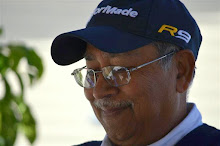Wednesday, July 31, 2024
The Half-Life of Knowledge in Engineering: A Personal Reflection
Saturday, July 27, 2024
Chaos juggled with humor wins
Subramanian had always been a curious man, and his curiosity often led him to the strangest of places. One day, he found himself climbing the hills beyond Rishikesh, seeking out sadhus who were known for their mystical powers. The hillside was dotted with holy men sitting under trees, each deep in meditation, looking like spiritual vendors displaying their wares to attract disciples.
Subramanian, however, wasn't interested in these regular sadhus. He had a very specific purpose in mind: he wanted to learn the art of bilocation—the ability to be in two places at once. This, he believed, would solve his most pressing problem back in Tamil Nadu: managing his two wives. He had read somewhere that Western saints could perform this trick, and he was determined to learn it.
As he ventured deeper into the jungle, the usual sadhus faded away, replaced by the sounds of nature. Finally, after hours of trekking, he stumbled upon a small clearing where an old sadhu sat cross-legged, his eyes closed, surrounded by an aura of tranquility.
"This must be the one," Subramanian thought, approaching with a mix of reverence and desperation.
The sadhu opened one eye, seemingly aware of Subramanian's presence. "What brings you here, my son?" he asked in a calm, deep voice.
"Great Sadhu, I seek the knowledge of bilocation," Subramanian replied earnestly. "I need it to manage my... complex domestic life."
The sadhu raised an eyebrow. "Bilocation? And why would you need such a skill?"
Subramanian explained his predicament: how he had ended up with two wives, each blissfully unaware of the other's existence, and how maintaining this delicate balance was becoming increasingly difficult.
The sadhu chuckled. "Ah, the things we men do for peace. Very well, I will teach you, but you must follow my instructions to the letter."
For the next few weeks, Subramanian trained under the sadhu's guidance. The exercises were bizarre: he had to meditate while balancing a coconut on his head, chant mantras while hopping on one foot, and even practice juggling with fire sticks. Despite the oddity of the tasks, Subramanian persevered, convinced that he was on the verge of mastering bilocation.
One day, the sadhu declared that Subramanian was ready. "Tonight, you will attempt bilocation," he said. "Find a quiet place, meditate deeply, and you will be in two places at once."
That night, Subramanian did as instructed. He found a secluded spot, sat down, and began his meditation. He felt a strange sensation, as if he was being stretched, and then—snap! He opened his eyes and found himself sitting in two places: one still in the jungle, and the other... in his home in Tamil Nadu, right between his two wives!
At first, Subramanian was thrilled. "It worked!" he thought. But his joy was short-lived. Both wives, startled by his sudden appearance, began questioning him simultaneously. He realized he could hear them both clearly, and worse, he had to answer both at the same time.
"Where have you been?" one asked.
"Why do you look so strange?" the other demanded.
As Subramanian tried to respond, he found that his words were jumbled, answering one wife's question with the other wife's answer. It was a comedy of errors. The more he tried to explain, the more entangled his lies became.
Finally, in a fit of panic, he tried to undo the bilocation, but he couldn't remember how. The sadhu hadn't taught him the return technique!
Back in the jungle, the sadhu was watching through his mystical powers and chuckling to himself. "Ah, the lessons we learn the hard way," he mused.
Subramanian spent the next few hours running between rooms, trying to keep up with both wives, who were now more suspicious than ever. Exhausted and desperate, he finally collapsed, wishing he had never sought out bilocation in the first place.
The next morning, Subramanian returned to the jungle, his face a mixture of fatigue and resignation. "Great Sadhu, I need your help. This bilocation is more trouble than it's worth."
The sadhu laughed heartily. "The secret to peace, my son, is not being in two places at once but being present where you are needed the most. Now, let me teach you the art of graceful escape."
And so, Subramanian learned the most valuable lesson of all: sometimes, the best magic is simply learning how to manage the chaos of life with a sense of humor and a lot of patience.
Thursday, July 25, 2024
"From Soviet Blueprints to Modern India: Personal Reflections on Russian Expertise, Friendship, and Unseen Ties
Saturday, July 20, 2024
Climbing the Stairway to Heaven: Journeying to Inner Peace and the Mystical Realms of the Mind
Thursday, July 18, 2024
### The Sweet Rewards of Higher Aspirations: Lessons from Nature and Life
Friday, July 12, 2024
The Strategic Edge: Harnessing the Power of Alternative Solutions in Management
ভাল থাকা
আমাদের বয়সে অভ্যাস টা নিয়ম মত চালিয়ে যেতে হয় l
ঐ যে ওঠার পর ফ্রেশ হয়ে নিয়ে একটু ফ্রি হ্যান্ড এক্সারসাইজ করা,তার পর চা বিস্কুট, কিছু ড্রাই ফ্রুট ব্যাস হাঁটার জন্য তৈরি l
লিফট অপারেটর প্রাণেশ হেঁসে বললো কি স্যার বৃষ্টি তেও ছাতার দিকে ইশারা করে l আমি মাথা নাড়লাম, ছেলেটা ভালো,ও জানে আমি কখন বের হই তখন লিফট থামিয়ে বেরিয়ে আমার জন্য অপেক্ষা করে অবশ্য কোনো কল না থাকলে!
আমদের বয়সে কেউ যখন চেনে তখন ভালই লাগে, retirement এর পরে লোকে আস্তে আস্তে ভুলতে বসে l আমরা যারা হাউজিং সোসাইটি থাকি তাদের একে অন্যর সংগে লিফটে তো দেখা হয়ে যাইই, তার পর ঘাড় নেড়ে বলা "ভাল" l কিন্তু যারা নিজের বাড়ি তে থাকে তাদের অবশ্য পাসের বাড়ীর সংগে আলাপ কিম্বা কাজের মাসির সংগে কথা বলা l সেদিন WhatsApp এ মেসেজ পেলাম যে যাদের বয়েস হচ্ছে তাদের বেশি করে কথা বলা l কথা না বললে আস্তে আস্তে আলজেইমার রোগ ধরবে lআমার বউ তো বলে আমি বেশি কথা বলি l শুনেছি আমাদের এক আন্তিও যে বেস বড় পোস্ট থেকে retire করার পর পয়সা দিয়ে বাচ্চা ছেলেদের ডেকে গালা গাল দিত, যতদুর মনে হয় তিনি ডিস্ট্রিক্ট ম্যাজিস্ট্রেট ছিলেন ইউপি তে, এলাহাবাদে থাকতেন! ঐ গালা গাল দেওয়া অভ্যাস ছিল, চোর ছেচড় কে নিয়ে ডিল করতে করতে গালা গাল দেওয়া অভ্যাস হয়ে গেছিল !
আমার অবশ্য ঐ রকম কোনো ইস্যু নেই হ্যাঁ এই একটু আড্ডা হলে মন্দ হয় না l
আমায় দেখে কেউ হাঁসলে অমি ও হেঁসে হাত তুলে বলি "ভাল তো"! অচেনা তো কি হয়েছে,এই তো সেদিন DKS ক্লাব বউয়ের সংগে বিকেলে চা আর চিকেন কাটলেট খেতে গিয়ে ছিলাম l কিছু দূর প্রায় আমার বয়সী একজন রোল খাচ্ছিল আর আমার দিকে তাকাচ্ছিল, কোথায় দেখেছি টাইপ, প্রায়ই হয় এরকম l
বিল সাইন করে উঠলাম যাবার সময় ওনাকে বললাম ভাল, হেঁসে বললেন হাঁ,আলাপ করলাম নিজের নাম বলে l ওনার নাম কুন্তল, বউ জিগেশ করলো চেনো ওনাকে, নাতো,এখন আর চেনার দরকার পড়ে না l হেঁসে কথা বলাই একটা বড় পাসপোর্ট l
যা বল ছিলাম বৃষ্টি তে লেকে হাঁটতে হাঁটতে এক marwari ভদ্রলোক আমাকে ছাতা নিয়ে হাঁটতে দেখে মাথা নাড়ল আমিও হেঁসে হাত নাড়লাম l ভাল লাগল যে দূর থেকে আরেক জনের সঙ্গে আলাপ হল!
এগুলো কে ইংরেজি তে বলে নোড্ডিং একুইন্টেন্স l
কিশোরের হিন্দি গান মনে পড়ে গেলো প্যার কিয়ে যা!
ভাগ্য ভাল যে আমদের চার দিকে এত লোক কথা বলার জন্য, শুধু একটু সহানুভূতি দরকার l
শেষ করি, বৃষ্টি এখনও পোড়ছে আর খিচুড়ির গন্ধ রান্না ঘর থেকে ভেসে আসছে!






